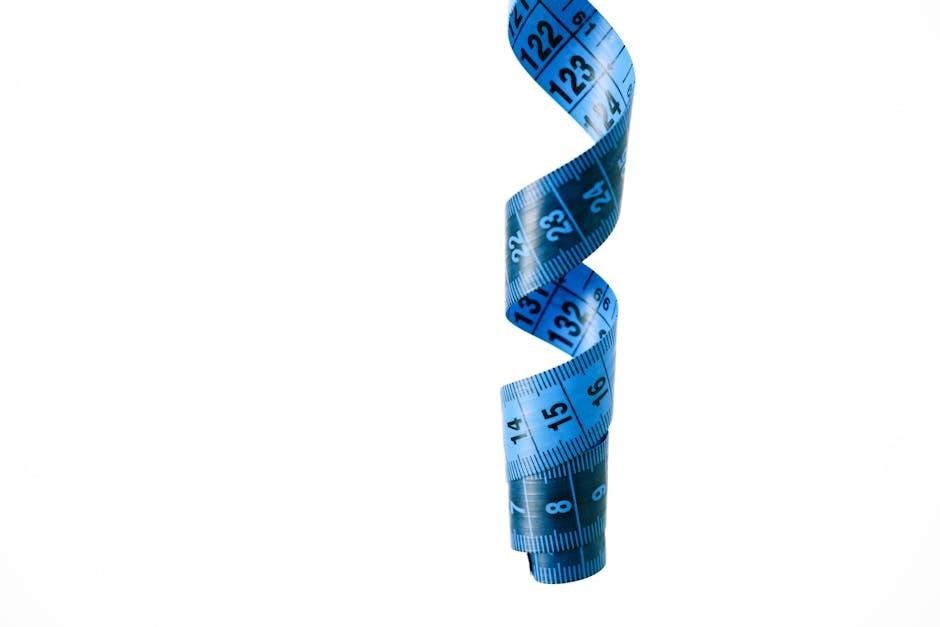inches to millimeters chart pdf
Understanding the relationship between inches and millimeters is essential for precise measurements. The conversion factor, 1 inch equals 25.4 millimeters, is fundamental for accurate transformations. This guide provides a comprehensive chart to simplify conversions, ensuring efficiency in engineering, manufacturing, and international trade. It serves as a reliable tool for standardizing measurements across various industries, facilitating global collaboration and precision.
1.1 Importance of Conversion Charts
Conversion charts are indispensable tools for ensuring accuracy and consistency in measurements. They provide a clear, visual reference for transforming inches to millimeters, which is crucial in industries like engineering, manufacturing, and construction. These charts help eliminate errors that arise from manual calculations, especially when dealing with complex fractions or decimals. By standardizing measurements, they facilitate international trade and collaboration, where both imperial and metric systems are used. Additionally, conversion charts serve as quick references, saving time and enhancing productivity in professional settings. Their widespread use underscores their importance in maintaining precision and efficiency across various fields. They are essential for anyone working with dual measurement systems.
1.2 Brief History of Measurement Systems
The history of measurement systems traces back to ancient civilizations, with early systems often based on local standards. The imperial system, including inches, originated in England, while the metric system, using millimeters, emerged in France during the French Revolution. Standardization became crucial as global trade and science demanded consistent measurements. The modern conversion between inches and millimeters was formalized in 1959 with the signing of the Treaty of the Meter, establishing 1 inch as exactly 25.4 millimeters. This standardization ensures accuracy and compatibility across industries worldwide, making conversion charts indispensable tools for bridging the two systems. Historical evolution highlights the importance of unified measurements in modern applications.

Step-by-Step Guide to Convert Inches to Millimeters
Converting inches to millimeters is straightforward using the conversion factor of 1 inch equals 25.4 millimeters. Simply multiply the inch value by 25.4 to obtain millimeters; For precise measurements, refer to the provided PDF chart, which includes both fractional and decimal inch values with their corresponding millimeter equivalents. This chart ensures quick and accurate conversions, essential for engineering, manufacturing, and other industries requiring exact measurements; By following this guide, you can efficiently convert inches to millimeters with ease and accuracy.
2.1 Understanding the Conversion Factor
The conversion factor between inches and millimeters is a critical element in ensuring accurate measurements. As per the data, 1 inch is equivalent to 25.4 millimeters, a standard derived from the metric system. This factor is crucial for engineers, manufacturers, and traders who rely on precise measurements. Utilizing this factor, one can easily convert inches to millimeters by multiplying the inch value by 25.4. The provided PDF chart simplifies this process by listing common inch measurements and their corresponding millimeter equivalents, making conversions quick and error-free. This consistency is vital for maintaining uniformity across global industries, facilitating seamless collaboration and trade. By understanding and applying this conversion factor, professionals can ensure the highest level of accuracy in their work. The chart serves as an indispensable tool, offering a straightforward method for conversions, thereby enhancing productivity and precision in various fields.
2.2 Practical Examples of Conversion
Practical examples of inches to millimeters conversions are essential for real-world applications. For instance, 1 inch equals 25.4 millimeters, while 2 inches equate to 50.8 millimeters. These examples are widely used in engineering and manufacturing to ensure precision. The conversion chart provides clear equivalences, such as 0.5 inches being 12.7 millimeters, simplifying measurements for professionals. By referencing the chart, users can quickly convert fractional or decimal inches to millimeters, ensuring accuracy in projects. These examples highlight the importance of standardized conversion methods, enabling seamless communication and execution across industries. They serve as a foundation for more complex calculations, making the chart an invaluable resource for everyday tasks. This practical approach guarantees consistency and reliability in measurements, fostering efficiency and reducing errors.
2.3 Common Conversion Errors and Solutions
Common errors in inches to millimeters conversions often stem from incorrect use of the conversion factor. A frequent mistake is forgetting to multiply inches by 25.4, leading to significant inaccuracies. Another error involves misinterpreting decimal places, causing measurement discrepancies. To avoid these issues, using a reliable conversion chart is crucial. It ensures that fractional and decimal inches are accurately converted without rounding errors. Additionally, double-checking calculations helps prevent mistakes. Regular practice with the chart enhances proficiency, reducing the likelihood of errors. By adhering to these solutions, users can maintain precision and reliability in their conversions, ensuring successful project outcomes across various industries. Proper training and reference tools are essential for minimizing conversion-related mistakes. This section provides practical advice to help users avoid common pitfalls, ensuring accuracy and efficiency in their work.

Detailed Inches to Millimeters Conversion Chart
This section provides a comprehensive and precise chart for converting inches to millimeters. It includes both fractional and decimal inch values, ensuring accuracy and ease of use for various applications.
3.1 Conversion Chart for Fractional Inches
The fractional inches conversion chart is a detailed reference tool that lists common fractional inch measurements alongside their exact millimeter equivalents. This chart is particularly useful for precise engineering and manufacturing applications where fractions of an inch are frequently used. It includes conversions for fractions such as 1/32, 1/16, 3/32, and more, providing a quick and accurate way to translate measurements without the need for complex calculations. By using this chart, professionals can ensure accuracy and consistency in their work, making it an indispensable resource for anyone working with fractional inches and millimeters.
3.2 Conversion Chart for Decimal Inches
The decimal inches conversion chart provides a straightforward method for converting decimal inch measurements to millimeters. By multiplying the decimal inch value by 25.4, users can quickly determine the equivalent measurement in millimeters. This chart is particularly useful for applications requiring precise conversions, such as engineering and manufacturing. It includes a range of decimal values, offering a seamless transition between the two measurement systems. The chart’s organized format ensures efficiency and accuracy, making it a valuable resource for professionals working with decimal inches and millimeters. Its simplicity and clarity make it an essential tool for ensuring precision in various technical fields.

Millimeters to Inches Conversion Chart
This chart simplifies converting millimeters to inches by multiplying mm by 0.03937. It covers various ranges, from small to large values, ensuring precise measurements for diverse applications.
4.1 Conversion Chart for Small Millimeter Values
A dedicated chart for converting small millimeter values to inches is crucial for precision in tasks requiring minute measurements. This chart typically covers millimeter values from 0 to 50mm, offering exact inch equivalents. It is particularly useful in fields like micro-engineering and precision manufacturing. By providing a clear, concise reference, it eliminates the need for complex calculations, ensuring accuracy and efficiency. This chart is essential for professionals who require quick, reliable conversions for small-scale projects and detailed craftsmanship, making it an indispensable tool in modern industries.
4.2 Conversion Chart for Large Millimeter Values
For projects involving larger dimensions, a conversion chart for substantial millimeter values is indispensable. This chart typically spans from 50mm to several hundred millimeters, providing precise inch equivalents. It is widely used in construction, heavy machinery, and large-scale manufacturing, where accuracy is critical. The chart simplifies conversions for extensive measurements, reducing errors and saving time. Professionals rely on this tool to ensure consistency and reliability in their work. By covering a broad range of millimeter values, it becomes an essential resource for industries that require precise measurement conversions on a larger scale.

Practical Applications of the Conversion Chart
The conversion chart is widely used in engineering, manufacturing, and international trade to ensure accurate measurements. It facilitates seamless communication between teams using different systems, enhancing collaboration and efficiency across global projects. Industries like aerospace, automotive, and construction rely on this tool for precise conversions, reducing errors and improving productivity. Additionally, it aids in educational settings, helping students understand metric and imperial systems. Its versatility makes it an indispensable resource for professionals and educators alike, ensuring consistent and reliable measurement conversions worldwide.
5.1 Use in Engineering and Manufacturing
In engineering and manufacturing, the inches to millimeters conversion chart is indispensable for ensuring precise measurements. It is widely used to design mechanical parts, tools, and machinery, where accuracy is critical. For instance, engineers rely on this chart to convert blueprints or technical drawings from imperial to metric systems seamlessly. This tool is particularly valuable in industries like aerospace and automotive, where components must meet exact specifications. Additionally, manufacturers use the chart to maintain consistency in production lines, especially when dealing with international suppliers or clients. By enabling quick and accurate conversions, it helps reduce errors and improves overall efficiency in the production process.
5.2 Use in International Trade and Commerce
The inches to millimeters conversion chart plays a vital role in facilitating international trade and commerce. Since different countries use either imperial or metric systems, this tool ensures smooth transactions between businesses globally. For example, suppliers in the United States using inches can easily convert measurements to millimeters for clients in Europe or Asia. This compatibility is crucial for product specifications, packaging, and shipping. The chart also aids in customs documentation, where precise measurements are necessary for tariffs and regulations. By bridging the gap between measurement systems, it fosters global collaboration and ensures that products meet international standards, reducing misunderstandings and enhancing trade efficiency worldwide.
Tips for Using the Conversion Chart Effectively
Always read the chart accurately, ensuring correct alignment of inches and millimeters. Double-check conversions for precision, especially in critical applications. Regularly verify the chart’s accuracy to minimize errors.
6.1 How to Read the Chart Accurately
To read the chart accurately, locate the inch measurement and align it with the corresponding millimeter value. Ensure you use the correct section for fractional or decimal inches. Always verify measurements by cross-referencing with the conversion formula: 1 inch = 25.4 mm. Pay attention to decimal placements to avoid errors. For example, 0.5 inches equals 12.7 mm. Use the chart systematically, starting from the smallest to the largest values. Regular practice enhances readability and precision, making the conversion process efficient and reliable for various applications.
6.2 Avoiding Common Mistakes
Avoiding common mistakes requires attention to detail and proper understanding of the conversion process. One frequent error is incorrect decimal placement, leading to inaccurate measurements. Ensure that when converting inches to millimeters, you multiply by 25.4, not divide. Another mistake is misaligning fractional and decimal columns. Always cross-verify using the formula to confirm conversions. Additionally, be cautious with mixed numbers, as improper fraction-to-decimal conversions can cause discrepancies. Regularly reviewing the chart and practicing conversions can minimize errors, ensuring precision and reliability in your work. Consistency is key to mastering the inches to millimeters conversion process effectively.
How to Download or Create Your Own PDF Chart
To download or create your own PDF chart for inches to millimeters conversion, start by searching trusted sources online. Websites like Amazon or specialized tool shops offer pre-designed charts. Use search terms like “inches to millimeters chart PDF” or “metric conversion chart printable.” For customization, use spreadsheet software like Excel or Google Sheets. Input the conversion data, ensuring accuracy, and include both fractional and decimal inches. Save the file as a PDF for easy printing. You can also find templates on platforms like Pinterest or Etsy. Once created, print the chart on durable paper or laminate it for long-term use. This ensures you have a handy reference for quick conversions in workshops, offices, or classrooms.